Nervous System’s quest for the best laser-cutting plywood
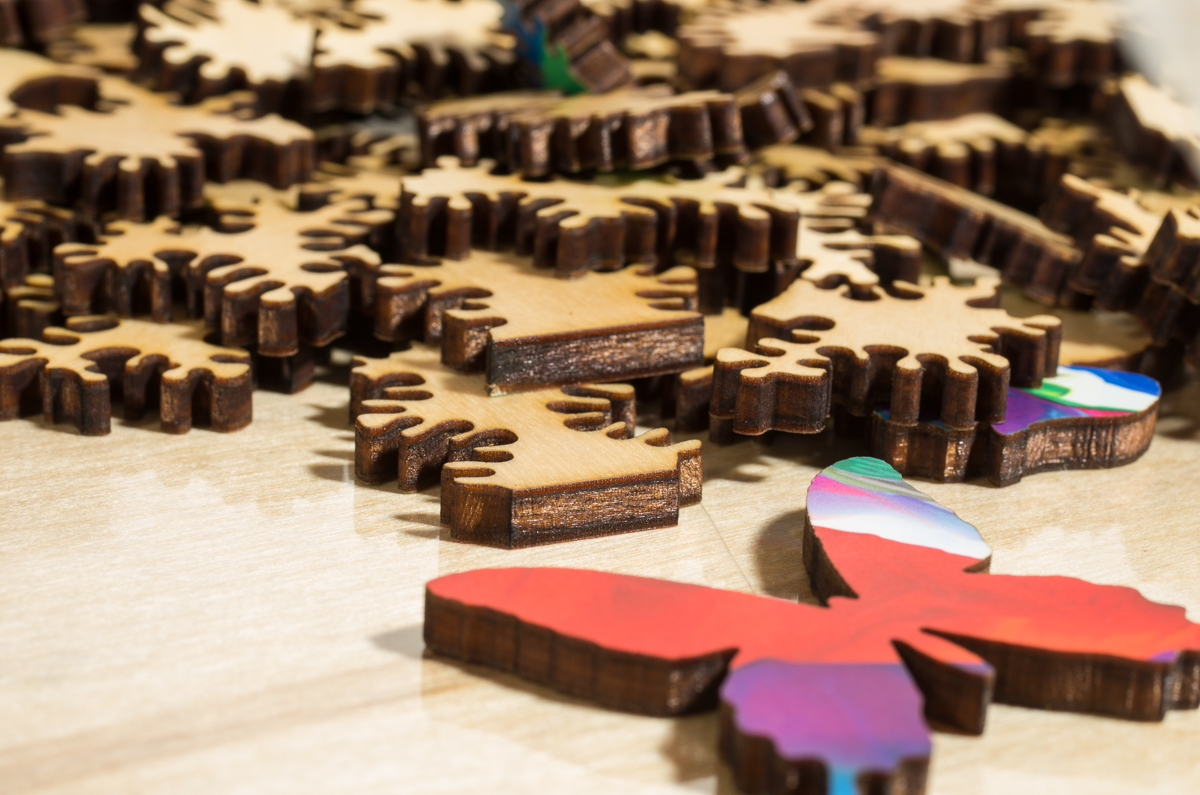
Four years ago, we began making laser-cut plywood jigsaw puzzles. In that time, we’ve gone through four different plywoods in search of a material that works well for laser cutting intricate parts. Along the way, we’ve learned a great deal about how plywood is produced and confronted a fundamental problem: There is no commercially available plywood made in the US designed specifically for laser-cutting. Ultimately, we’ve had to have our own custom plywood manufactured.
what makes a plywood good for laser cutting
Laser-cutting works best with uniform, consistent materials. Wood is a natural material and hence not at all consistent! It contains irregularities like knots and voids and differences in density due to its grain. When making an intricate puzzle, the demands on the laser are even more rigorous. The material is going to be cut everywhere, in dense patterns that cover the entire piece. Any irregularities in the wood can’t be avoided or “cut around.” Unlike a saw, a laser can only cut at one power. It can’t speed up on a soft spot, or push harder when it hits a snag. If you encounter an area of material that is very different from the rest while laser-cutting, you have a big problem. Because of the puzzle image, any errors cannot be recut, so if you hit a bad spot, the entire piece is ruined.
Furthermore, while lasers can cut wood just fine, they have a much harder time cutting most types of glue. Since plywood is a sandwich of glue and wood this is problematic.
Industry issues: Grades, veneers, plys and glue
plywood grading
The plywood industry makes finding a good wood for laser cutting extraordinarily difficult. Most plywood is described and graded solely by its exterior veneers. But, for laser cutting the interior layers of wood or “core plys” are just as, if not more, important. Any inconsistencies inside the plywood will prevent the laser from cutting through. In addition to not having a grade to tell you about knots and voids, often wood distributors don’t specify what the core is made of at all. Wood manufacturers will not even guarantee the cores will be made out of consistent species; they simply use whatever is available, which can change with each batch.
multi-ply quandary
Traditionally, if you’re looking for the most stable and consistent plywood, you will be recommended a multi-ply wood. These are plywoods with thinner inner plys (so, for example, a 1/4″ material would have 5 plys instead of the usual 3). Multi-ply woods also usually have a specific type of core material — the most common being Baltic Birch. But extra plys are exactly the opposite of what we want for laser cutting intricate parts. In traditional woodwork, extra plys mean more redundancy and stability, so that if one area has a bad spot, the other layers will make up for it. But to the laser, more layers means that many more opportunities for a bad spot to exist, and a single one in any layer could ruin the cut. An insidious side effect of this situation is that regular core plywoods with fewer plys are typically of lower quality, since if people wanted higher quality wood, they’d buy one with more plys, right?
glue
Additionally, more layers means more glue and the glue portion of plywood is often harder to cut than the wood itself. Plywood can be made with several different types of glue. Plywood for use indoors is typically made with urea-based glue and plywood for use outdoors is made with phenolic-based glue. Extra-durable plywoods, like aircraft-grade woods were attractive to us for their rigorous specification for high-quality cores but these are always made with the phenolic-based glue. Phenolic glue takes at least 4 times as much power to cut by laser as urea glue. This results in puzzles that take longer to make and that are more singed at the end. But it gets even worse! After discovering tiny metal flakes in the glue of some of our plywood — metal flakes that reflect the laser, causing all sorts of havoc — we assumed that they must have worked their way into the layers accidentally…but we were shocked to learn that this metal “glitter” is intentionally embedded in the glue, to help manufacturers identify their wood!
Getting our wishes granted
So our wish-list for plywood seemed simple — very high quality plywood with void- and knot-free veneers and cores, and interior grade glue with no $@%! metal flakes — but for a long time, it proved nearly impossible to find.
We tried:
- Various woods suggested by our local supplier, including birch and italian poplar
- these had big areas of filler that didn’t cut well on the laser, as well as many inconsistencies in general
- we learned from this that people who know plywood and the plywood industry don’t generally know about laser-cutting or its requirements
- Hunted on the Internet and found a good two-sided birch plywood we liked: Because it was two-sided, both veneers were of high quality, and we were excited to see no core problems showing through on either side
- but then the manufacturer switched cores shortly thereafter
- We began ordering CANAM plywood from Columbia
- as a major international distributor / supplier, this wood wasn’t going to change…but about 50% of what we received was too low-quality for us to use
- we had to painstakingly check each piece under a bright light to look for voids and knots before cutting
- it had those awful metal flakes in the glue
- …and eventually, the only local distributor of CANAM woods in our area stopped stocking the one we needed.
- Being very frustrated.
- Why couldn’t we just buy a high quality plywood for laser-cutting??
Finally though, we decided to take a big step and, armed with our now-thorough knowledge of what we needed, strike out on our own.
From the ground up: Custom manufacture
It sounded crazy to us at first, but once we’d run out of other options, we started making calls — specifically, we tracked down a small-scale manufacturer who specialized in aircraft-grade custom plywoods.
Fortunately, this story has a happy ending, because while having your own bespoke plywood manufactured seems a little extreme, it’s actually not that difficult or unreasonable. The manufacturer we found was able to provide us with our plywood holy grail:
- a 3-ply 5mm wood
- basswood core with birch veneers, both very high quality
- using a melamine-based glue instead of the usual phenolic
So far this wood has been amazing. No longer must we carefully inspect each piece of a 400 piece puzzle, dreading the possibility that we will find an irreparable damaged area. This is by far the best plywood we have ever laser cut, and after 4 years we’ve tried almost everything.


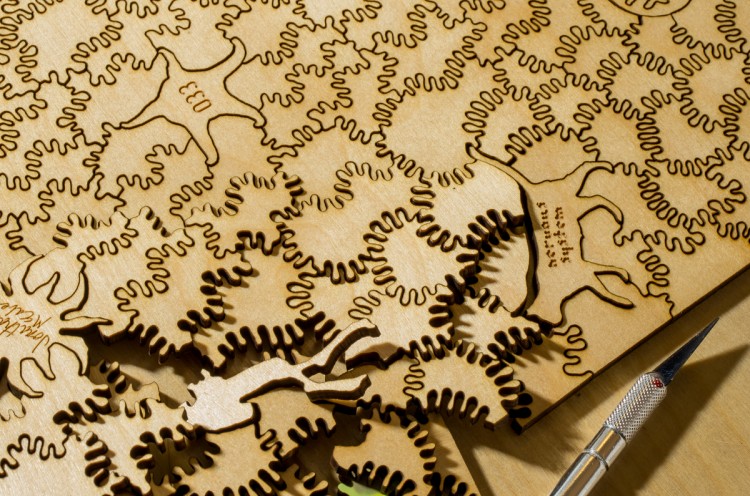
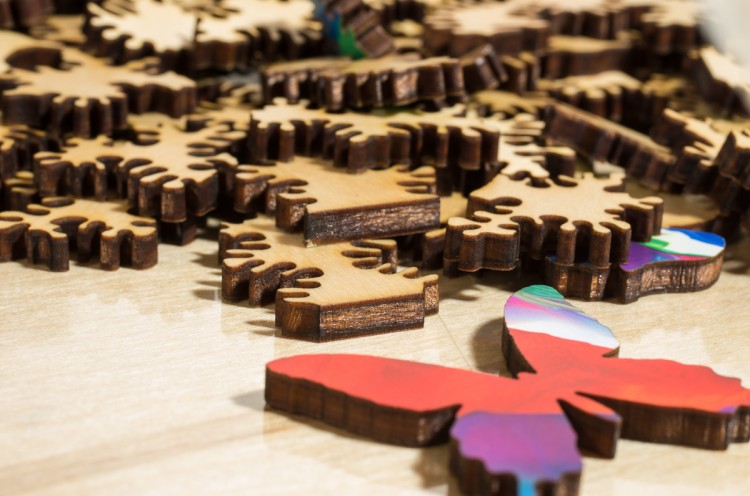
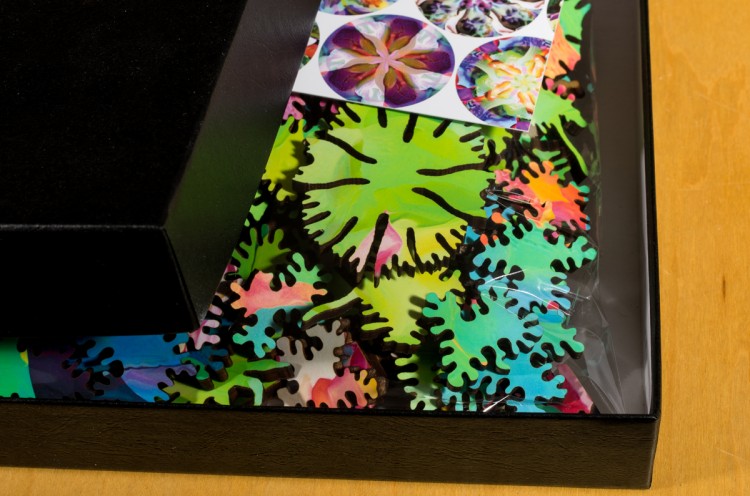
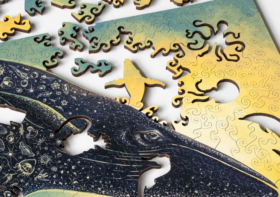
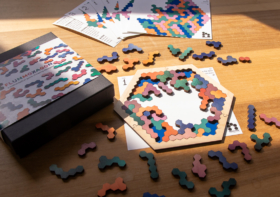

Jennifer Leigh
Is it possible for other folks to obtain this plywood for our own projects?
thanks!
-jennifer
Russ Sheard
This is the most informative , educational and enlightening article I could ever hope to find . As I am about a year in to my puzzle making quest .
I can identify with virtually every aspect of the same problems that you encountered along the way.
Sharing your knowledge on the subject is going to make a significant
impact on how I move forward. In turn I may keep my sanity !
I am truly thankful that you have shared your knowledge.
josh g.
Did you try using thin sheets of solid wood instead of plywood, or was that considered too expensive? Curious how the inconsistencies compare vs plywood. (I’ve been doing small laser-cut projects from solid hardwood, but only small runs of very small final products.)
Jesse Louis-Rosenberg
We have cut solid wood on our laser before too, but it is not really an appropriate puzzle material. You need the stability and robustness that comes from a laminate when you have something that detailed which will be handled fairly roughly.
Carl
Can I buy some of this wood from you?
Marie Staver
Hi Carl! No, we don’t sell the wood. But a manufacturer of specialized or aircraft plywood should be able to make it for you using the information in this article, if you want the same kind we have! Good luck, and let us know if you need any more information.
Best,
Marie @ Nervous System
Amy Leach
This is a truly amazing piece of art! It really is amazing how precise a laser can be!
Esjay Bee
Possible to share the name of the manufacturer you’re buying from?
Jessica
We work with Jerome at http://www.aircraftplywood.com
henrik
Hi Jessica! I’m making a building set out of wood using a laser cutter. The pieces are flat and has multiple slits. This allows you to put the pieces together in multiple ways. My problem is that, when laser cutting, the pieces gets charred and burned along the cutting edge, so that when assembling the pieces together they leave ash marks on each other. How did you deal with the burned edges on your pieces? If you run your finger alongside your pieces, do you get ash on your finger?
Do you know of any wood type or plywood that doesn’t charr that much?
Best,
henrik
Jessica
Hello Henrik,
Getting the plywood to cut cleanly is a matter of tuning your laser speed and power correctly. Cutting slower, with a lower power will result in a clean edge without char. Our edges are golden brown not black and do not leave soot on your finger when handling. You also need a strong exhaust system that will suck away the dust produced when cutting through the wood. Good luck!
Andrey
damp the piece of wood with water before cutting to avoid burning marks
Ian Grant
I read your article with interest as I’m having difficult cutting precise shapes out of plywood with my laser. The issue I’m having is with the nature of the plywood – as it is bowed and warped. When I use the manual focus adjustment it will cut out some section, but it won’t completely cut out the others which are not at the correct adjustment for the laser. I am placing weights on the plywood to try and make it as flat as possible and only getting the laser to cut out a small section at a time. Are you having any of these difficulties and if so, would you be so kind as to offer advice on how to overcome it?
Regards, Ian
Jessica
Hi Ian, Yes! you really need your plywood to be flat. Don’t buy warped plywood. There are ways to try and flatten it but its easiest just to start with good quality material.
Dave
Google ‘bass core plywood’ and you will find several sources, including this one: http://aircraftproducts.wicksaircraft.com/viewitems/aircraft-plywood/ple-and-basswood-plywood-aircraft-grade-mil-p-6070?
Jessica
aircraft plywood almost always uses exterior grade glue which cuts significantly worse with a laser
Pete
I definitely have a few questions. In my experience with Basswood, it doesn’t take wet media very well. It always warps and buckles. I make gears and other items out of 1/8″ Baltic Birch from Ocooch which has the stuff quite cheap for the quality and I order in bulk to get a break. But I run into the same issue constantly, of the cuts not making it all the way through. If I have Items to a board, I can guess at least 3 will be ruined sometimes almost half, depending on the piece.
My questions are; does the Basswood have any negative aspects (warping)? Does the Melamine binder make it more stable? And More importantly if all I have is an exhaust fan/tube, do I have to worry about the toxicity levels of cutting a Melamine binder in my apartment, for the safety of me, my girlfriend, and our Kitty?
Very interested!
Fantastic Article!
Let me know!
Jessica
Hi Pete,
Sorry for the slow reply! I’m not sure about your wet media question. We don’t get our plywood wet during our puzzle making process as we mount images with a heat press. But also it’s a plywood, the core is basswood and the outer veneers are birch with layers of melamine resin reinforced glue between them…so the basswood portion isn’t exposed on the surface.
This plywood (like most) is very stable and does not warp as easily as solid wood. The melamine binder makes it easier to cut than exterior grade glues. I don’t know anything about the toxicity of melamine…but it is very commonly lasercut.
Greg
I found the 5.2mm ply from lasercutply.com to be a really nice plywood. They have a handful of other materials as well that work well. A good source for 1/8″ MDF which can be hard to find
Burak
Not sure that lasercutply.com is an active site. I have filled out an order and did not even receive a confirmation e-mail for the order. They also do not provide an e-mail or a phone number to call on their website.
Claire
This laser cut wonders remind me of hattifatteners! Amazing:)
Joe Simth
Try this stuff, top quality and specifically designed for laser cutting small intricate items :)
http://www.koskisen.com/products/koskiply-economy/
Jessica
thanks for the tip. Their products do not appear to be available in the United States.
Jarno
You can by this via http://www.pdusa.com
1435 Morris Avenue
NJ 07083, Union
United States
GSM: 1-908-687-7890
heikki kiesila
good day, interestings discussion indeed. Koskisen in Finland is producing birch thinplywoods designed for laser cutting. pls see https://www.koskisen.com/koskisen/thin-plywood-and-veneers/
we can surely find best options for your laser works.
Kim Evans
What type of adhesive, glue, modg podg do you use to attach the picture to the wood?
Jessica
We use a drymount press to attach the art to the plywood
Kunka Velikova
Jessica , we produce children toys in Bulgaria,a social entreprise
Do you attach the picture before or after you lasercut it? Thanks so much!
Margaret Swanson
hello. We mount the image before we lasercut the puzzle
Brenda
You answered so many questions and solved so many issues I’ve been having. Thank You!
Jan Kiefhaber
HI, I am a granny with a new toy. I got a Glowforge and would LOVE to make simple puzzles for my grand kids.
Do you think it would be possible to do a laser print of artwork, and then take it to Fedex Office to drymount to the plywood? Would this suffice to make a simple puzzle? If so, could you recommend the weight of the paper to be printed? Is there a special instruction for drymounting (or certain type of adhering material?) Thank you for your patience with this. Granny Google
Andrew Crawford
Hi! I know your post is a year old but, just in case you (or anyone else who reads this later) are still looking for help, There are a lot of people making puzzles posting on the official Glowforge forums. Several of them seem to have it pretty well down.
Atman
Hello Jessica. Thank you very much for this insightful article. I’ve been struggling with the same issue for a looong time.
Could you please tell me if you’ve tried combi wood or eucalyptus wood instead of basswood for the core?
My supplier does not have basswood and offering me a replacement and I have no idea if it’s going to be ok for the product.
Appreciate your time!
Margaret Swanson
We haven’t tried either, so I’m afraid we can’t offer any insight into how they might work out. If you end up trying one of those, please let us know how it goes for you!
manny torres
awesome article! thanks for the insight and resources!
_mt
Andrew H
Wow, how are you engraving with so little scorch marks in those images? I see a lot of advice suggesting using tape on the top surface but it doesn’t appear like that is what you guys are doing
lj
Just curious, what was your issue with the Italian poplar wood?
Jessica
primarily knots
MK
what about MDF … or even No-added Formaldehyde MDF?
Jerry
Hi Jessica.
Great article. Thank you, you’ve answered so many of my questions. How do you heat press the image onto the plywood? Is it regular photography paper? what kind of glue do you use? Do you prime the plywood first? I’ve heard that some people cut their puzzles with the image upside down because the laser actually cuts in a slight “V” shape and this produces a tighter puzzle and looks nicer. Is their truth to that? Thank you…
MK
Hello.. i was just wondering what you think of mdf and have you considered using it instead of plywood? isn’t it more solid? i heard there was NAF panels (no added formaldehyde).